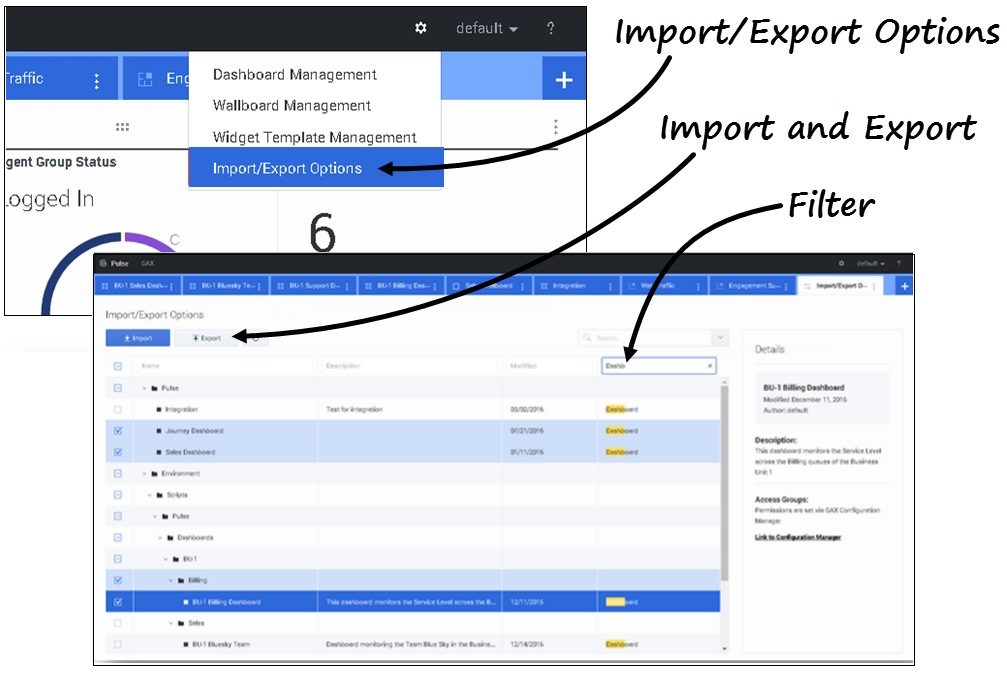Difference between revisions of "PEC-REP/Current/RT/RTRImportExport"
From Genesys Documentation
m (Text replacement - "\|Platform=([^\|]*)GenesysEngage-onpremises([\|]*)" to "|Platform=$1GenesysEngage-cloud$2") |
(Published) |
||
| Line 8: | Line 8: | ||
|Role=Supervisor | |Role=Supervisor | ||
|Application=Pulse Reporting | |Application=Pulse Reporting | ||
| − | |||
|Section={{Section | |Section={{Section | ||
|sectionHeading=Import and export of custom dashboards, wallboards, and templates | |sectionHeading=Import and export of custom dashboards, wallboards, and templates | ||
| Line 21: | Line 20: | ||
#Select '''Import/Export options''' from the top right menu. | #Select '''Import/Export options''' from the top right menu. | ||
#Select any dashboards, wallboards, and widget templates from the centralized repository. You can also apply a filter on the type of objects or the name of dashboards | #Select any dashboards, wallboards, and widget templates from the centralized repository. You can also apply a filter on the type of objects or the name of dashboards | ||
| − | #Click '''Export''' to save a package file ( | + | #Click '''Export''' to save a package file (JSON format) into your system. |
====Import package file to another environment==== | ====Import package file to another environment==== | ||
| Line 29: | Line 28: | ||
#Select the dashboards, wallboards, and widget templates from package file to import into your current environment | #Select the dashboards, wallboards, and widget templates from package file to import into your current environment | ||
#Click '''Import'''. | #Click '''Import'''. | ||
| − | |||
| − | |||
|Status=No | |Status=No | ||
}}{{Section | }}{{Section | ||
| Line 36: | Line 33: | ||
|anchor=WhatdoIdonext | |anchor=WhatdoIdonext | ||
|alignment=Vertical | |alignment=Vertical | ||
| − | |||
| − | |||
|structuredtext=You might want to learn more about: | |structuredtext=You might want to learn more about: | ||
*{{Link-SomewhereInThisManual|topic=RTRUserAccess|anchor=|display text=Dashboards and Wallboards }} | *{{Link-SomewhereInThisManual|topic=RTRUserAccess|anchor=|display text=Dashboards and Wallboards }} | ||
*{{Link-SomewhereInThisManual|topic=RTRTemplates|anchor=|display text=Manage Report Templates }} | *{{Link-SomewhereInThisManual|topic=RTRTemplates|anchor=|display text=Manage Report Templates }} | ||
| − | |||
| − | |||
|Status=No | |Status=No | ||
}} | }} | ||
}} | }} | ||
Revision as of 12:29, July 15, 2021
Contents
Export dashboards, wallboards, and templates from one environment to another.
Related documentation:
Import and export of custom dashboards, wallboards, and templates
You can export dashboards, wallboards, and templates from one environment to another. This means after you create your own custom content based on the business requirements, you can easily build a package to use in other environments.
Export package file from your environment
- Select Import/Export options from the top right menu.
- Select any dashboards, wallboards, and widget templates from the centralized repository. You can also apply a filter on the type of objects or the name of dashboards
- Click Export to save a package file (JSON format) into your system.
Import package file to another environment
- In the other environment, select Import/Export options from the top right menu.
- Click Import to select a previously exported package file.
- Select the dashboards, wallboards, and widget templates from package file to import into your current environment
- Click Import.
What do I do next?
You might want to learn more about:
Comments or questions about this documentation? Contact us for support!

